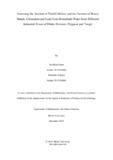| dc.contributor.advisor | Mosharraf, Fahareen Binta | |
| dc.contributor.author | Islam, Isra Binte | |
| dc.contributor.author | Alamgir, Shamaila | |
| dc.date.accessioned | 2020-10-29T04:38:11Z | |
| dc.date.available | 2020-10-29T04:38:11Z | |
| dc.date.copyright | 2019 | |
| dc.date.issued | 2019-12 | |
| dc.identifier.other | ID: 15326006 | |
| dc.identifier.other | ID: 15326004 | |
| dc.identifier.uri | http://hdl.handle.net/10361/14072 | |
| dc.description | This thesis is submitted in partial fulfilment of the requirements for the degree of Bachelor of Science in Microbiology, 2019. | en_US |
| dc.description | Catalogued from PDF version of thesis. | |
| dc.description | Includes bibliographical references (pages 44-47). | |
| dc.description.abstract | The immensity of the global safe water crisis is underrated, though for decades’ water has
been contemplated as the most imperative natural finite resources that is required for human
development and existence. The accessibility and availability of fresh clean water does not
only play a crucial role in economic development and social welfare but also a help to raise
awareness regarding potential risk of pathogens and heavy metals from natural water
reservoir. Escherichia coli, Enterobacter, Salmonella and Shigella are one of the major
causes of gastroenteritis worldwide. Due to the presence of related genotypic strains, it is
reported that natural water bodies can be served as reservoir for the dissemination of these
strains in environment. Besides, human are exposed to harmful heavy metals in several ways
ranging from consumption of contaminated food and water as well as exposure to polluted air
droplets. Nevertheless, innumerable studies have been carried out over the years to assess the
impact of disease causing organisms in water quality management, our scientific research
showed renewed interest to standardize and evaluate the qualitative as well as quantitative
assessment of water quality. In such instance the focus of this experiment is to identify the
presence of Escherichia coli., Enterobacter, Salmonella and Shigella, along with presence of
toxic chemicals like Lead (Pb) and Chromium (Cr). The presence of high concentration of the
heavy metals in water may posture substantial health risks along with the impact caused by
Escherichia coli, Enterobacter, Salmonella and Shigella. So constant checking of both
chemical and biological quality of natural water sources is highly recommended. The
literature reported here focused on a parallel assessment of the levels of the toxic chemicals
like Lead and Chromium in distinct locations Tongi and Tejgaon Industrial Zone, Dhaka city
within the period of May to December, 2019 along with the presence of Escherichia coli.,
Enterobacter, Salmonella and Shigella. Finally, the results portrayed that the in presence of
harmful chemicals organisms like Escherichia coli., Enterobacter, Salmonella and Shigella
can sustain for a longer time in water which can show long term impact on human and
environment that is yet to be studied at in vivo condition considering the fact how this factors
will be associated with human exposure to wastewater in the industrial zone. | en_US |
| dc.description.statementofresponsibility | Isra Binte Islam | |
| dc.description.statementofresponsibility | Shamaila Alamgir | |
| dc.format.extent | 56 pages | |
| dc.language.iso | en_US | en_US |
| dc.publisher | Brac University | en_US |
| dc.rights | Brac University theses are protected by copyright. They may be viewed from this source for any purpose, but reproduction or distribution in any format is prohibited without written permission. | |
| dc.subject | Coliform | en_US |
| dc.subject | Heavy metals | en_US |
| dc.subject | Chromium (Cr) | en_US |
| dc.subject | Lead (Pb) | en_US |
| dc.subject | Household water | en_US |
| dc.subject | Industrial zones | en_US |
| dc.subject | Dhaka Division | en_US |
| dc.title | Assessing the amount of total Coliform and the amount of Heavy Metals, Chromium and Lead from household water from different industrial zones of Dhaka Division (Tejgaon and Tongi) | en_US |
| dc.type | Thesis | en_US |
| dc.contributor.department | Department of Mathematics and Natural Sciences, Brac University | |
| dc.description.degree | B. Microbiology | |

